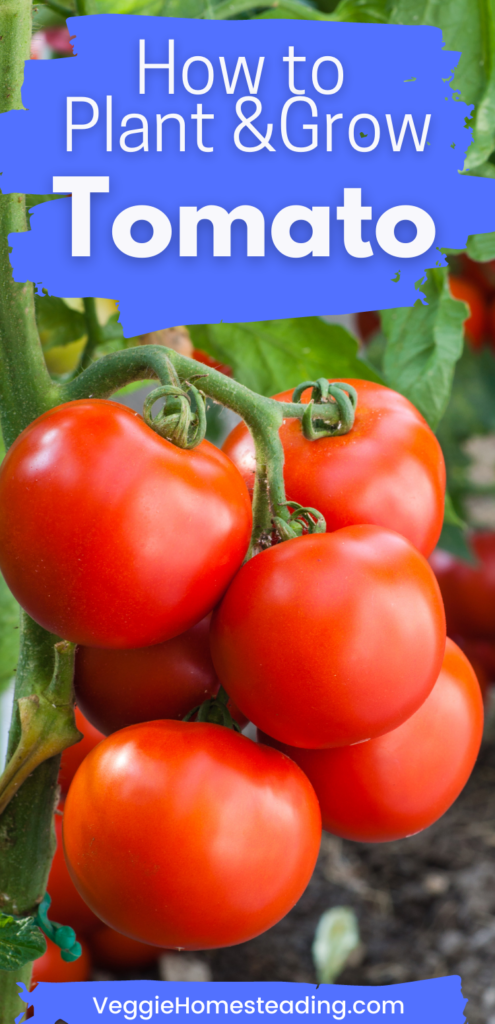Information about planting and growing tomatoes including from plants or seeds.
Botanical Information: Solanum lycopersicum
Quick Facts:
Hardiness Zones: 4-11

Tomato Varieties
There are a wide varieties of tomatoes from grape tomatoes to beef steak tomatoes.
Big Boy
Italian Roma
Dwarf Heirloom Cherry Tomatoes
Starting
Tomatoes are most fruitful when the seeds are started indoors around the beginning of May, specifically 6 to 8 weeks before the average last spring frost date. These can then be transplanted outdoors near the beginning of July, after the last spring frost when the soil has warmed.
You may also start growing tomatoes by buying tomato plants that have already been started and plant them outdoors. This is the chosen route by many and the easiest for beginners to start with.
If you choose to start seeds inside and transplant, two weeks before planting your tomato plants outdoors, dig into the soil. Do this about 1 foot deep and mix in aged manure or compost. This will ready the soil for the plants.
Also, take your plants outdoors for a few hours a day, preferably in the morning, to get them used to being outside. Gradually increase the amount of time each day, over the course of a week.

Planting
At the time of planting, place tomato stakes or cages into the soil. This will reduce the chances of damaging the roots later on. Stakes will keep the fruit from touching the soil while cages will keep the plant standing upright.
Before planting transplants, apply 2-3 lbs of complete fertilizer, per 100 square feet of garden area. Do not spread high nitrogen fertilizer, though. Fertilizer high in nitrogen will promote luxurious foliage but will delay fruiting.
Spacing
Tomato plant rows should be 4 feet apart from one another.
Small bush type plants as well as larger plants that will be staked should be planted 2 feet away from each other. Large plants that you do not plan to stake, should be planted 3-4 feet apart.
Before planting, trim off the lower branches to allow the root ball to be planted deep enough that remaining leaves graze the top of the soil.
After transplanting, water the plant completely. This will help the root and soil create good contact and prevent wilting of the plant.
Shading the transplanted plants for the first week is important to prevent excess drying of the leaves and to allow the soil and roots to make connection.
Companions and Enemies
Plants that will help a tomato plant grow include basil, parsley, garlic, squash, asparagus and chives.
Ones that could hinder or prevent tomatoes from flourishing are cabbage, cauliflower, brussel sprouts and carrots.
Watering
Watering should be done generously for the first few days.
Throughout the growing season, tomato plants should be watered well. This means about 2 inches per week during the summer. Deeply watering will help strengthen the root system.
Watering in the early morning will help the plant have the water needed to make it through a hot day.
Light
Tomato plants need full sun to grow properly. For areas in the Northern region of the United States, 6 hours of sun per day is crucial. For the southern areas of the country, light afternoon shade will keep tomatoes from the harsh sun which will help them grow.

Maintenance
Mulching approximately 5 weeks after transplanting will help keep moisture in for the plant and will also help to prevent weeds. Apply 2 to 4 inches of organic mulch after the soil has warmed up.
During a drought, placing rocks over the mulch and dirt can help prevent evaporation from the soil.
Fertilizer should be given at first during watering to help ensure the roots are strong.
When tomato fruits are about 1 inch in diameter, fertilize or compost every two weeks.
If no mulch is used, removing weeds is important. Herbicides may be used but is not suggested in small gardens with only a few plants.
Pollination
Tomatoes are self-fertile. This means that each flower on a tomato plant can pollinate itself. It has low vibration which quite literally shakes the pollen free, allowing it to drop onto the stigma, which is the female part of the flower that catches the pollen. Wind also helps this process along.
In a greenhouse, self pollination may not be enough in some situations. Since there is no wind in a greenhouse, you may want other options on tap. One is to have bees in your greenhouse. Another is manually pollinating by gently shaking the plants.

Common Problems
Tomatoes are susceptible to insect pests. The most common are hornworms and whiteflies. Other possibilities are aphids and flea beetles.
Fungus and disease can also effect tomato plants. This includes blossom end rot, late blight and mosaic virus.
Cracking on the fruit can also happen. This is when growth occurs to quickly. Typically this is because of uneven watering, either from weather or otherwise. This is why mulch and consistent watering is suggested.
Harvesting
Even though you will be excited to harvest your tomatoes, it is best to leave them on the vine as long as possible. A tomato that is ready to harvest will be firm and very red in color, regardless of size. It may have yellow around the stem, this is okay. If you are growing tomatoes of other colors, leave them on the vine until they reach the color they are meant to be.
Sometimes tomatoes can fall off the vines before they are completely ripe. Placing them in a paper bag will help. Placing them on a sunny window sill has been suggested in part of history, but this can cause the fruit to rot before it is ripe.
If your tomato plant has fruit that is not ripe and the first fierce frost is threatening, pull the entire plant from the ground and hang it upside down in a basement or garage.
Preparing
After you are done growing tomatoes, how you store tomatoes is important. Placing fresh tomatoes in the fridge can cause spoilage of the flavor and texture.

If you aren’t going to eat the tomatoes fresh, there are a few options for long term storage.
Freezing is an option. To do this, start by taking the core of the tomatoes out. Place them whole in freezer bags or containers. Seal them properly. When the tomatoes are defrosted, the skins will slide off. Read This for more information about Freezing.
Tomatoes can also be canned for preservation.


Leave a Reply